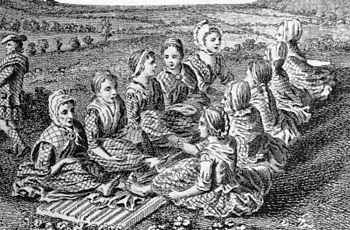While I am on my musings of wool, I thought I ought to address a peculiar form textile history, and it’s accompanying folk music. It is a way of finishing wool, that is unique to Scotland. It is the waulking the tweed, and there is a whole library of waulking songs to go with it. I am not sure why Ireland does not share this type of music, since it certainly has it’s own fair share of sheep, wool, and tweed, but it does not. It’s all Scottish.
I was introduced to the waulking song when I was taking Scot’s Gaelic lessons. My ever patient and wonderful teacher, Ashby, tossed in quite a few good tidbits of Scottish culture along with the noun declinations that were so difficult for me. One of these was the waulking song.
When you weave wool, it needs to then be fulled—or softened and felted up a tiny bit before it is ready to sew. If you do not do this, you will find that your seams will unravel and you will not have a long lasting garment. It took quite a long time to spin and weave cloth. It had better last a long time, no?
The fulling, or waulking, was done by hand by the ladies of the village. I’d liken it to a sort of quilting bee. It was a way to share a long and laborious task, and make light work of it. The ladies would gather around a long table, grab handfuls of the fabric as it was spread before them, and rhythmically beat it against the table. They’d shift the fabric top the left as they worked so as to address all of the fabric. This was so important a cultural activity that the Scots carried it with them over the pond during the clearances to Nova Scotia. There they called it “milling” the tweed, and the men got in on the action. I highly approve of that change! I’d love to have such a waulking table. I can imagine how smooth and wonderful a patina it would have after years of such polishing!
This driving rhythm of waulking, and the repetitive, monotonous task that it is, demands a song to make light of the work. This is where the waulking song comes in. There is a caller, who sings the verses of the song, and the rest of the ladies would answer the caller in a chorus. There are many, many such songs, a few of which have been recorded by folk/pop groups such as the renowned Capercaillie. You saw the lead singer of Capercaillie, and heard their music in the movie Rob Roy. The lead singer, Karen Matheson, sang a song in Gaelic about a lost love, as Eric Stoltz was being murdered by Tim Roth. Wonderful movie. Great music. There is something riveting about the music, and it’s great music to get you going on your own projects.
You can check out some waulking songs like Alasdair Mhic (Capercaille) and Gaol lse gaol (Kathleen MacInnes) all over YouTube. Use it to inspire your work, get you going through a long task, and feel connected to the long history of textiles and sewing.

